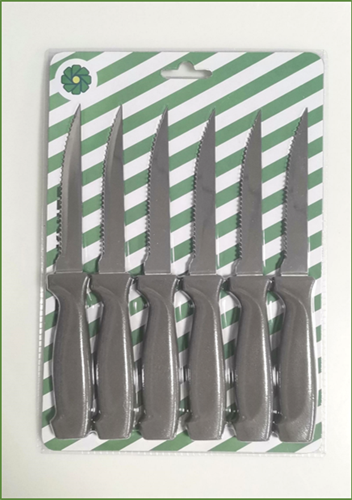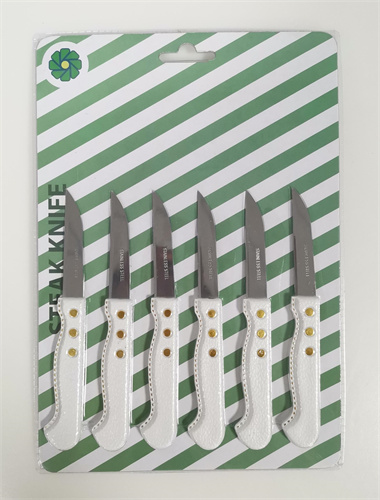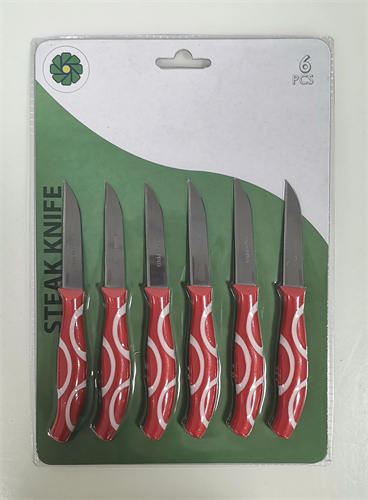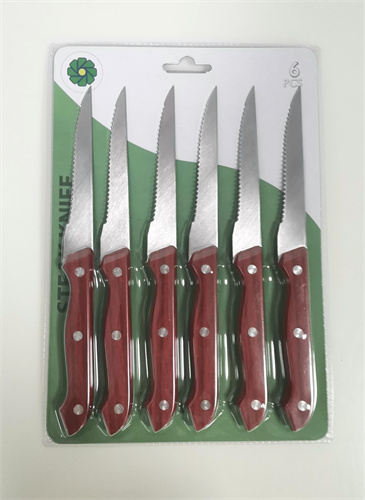

Views: 900 Author: sales@insightknife.com.cn Publish Time: 2025-01-06 Origin: Site








Content Menu
>> Importance of Sharp Steak Knives
● Regular Maintenance Practices
>> Professional Sharpening Services
● Frequently Asked Questions regarding Steak Knives
>> 1. How often should I sharpen my steak knives?
>> 2. What is the best way to clean steak knives?
>> 3. Can I use a whetstone to sharpen serrated steak knives?
>> 4. What type of cutting board is best for steak knives?
>> 5. Is it necessary to hone my steak knives?
Steak knives are essential tools in any kitchen, especially for those who enjoy a good steak. A sharp knife not only enhances the dining experience but also ensures safety while cutting. Maintaining the sharpness of steak knives requires regular care and attention. This article will explore various maintenance tips to keep your steak knives sharp and effective, ensuring they remain a reliable companion for your culinary adventures.
Steak knives come in various types, primarily categorized into straight-edge and serrated knives. Understanding the differences between these types can help you choose the right knife for your needs and maintain them accordingly.
Straight-edge knives have a smooth blade that is easier to sharpen and maintain. They provide clean cuts and are ideal for slicing through tender cuts of meat, such as filet mignon or ribeye. The precision of a straight-edge knife allows for thin, even slices, enhancing the presentation of your dish. Additionally, these knives can be used for a variety of other tasks in the kitchen, making them versatile tools.
Serrated knives feature a saw-like edge that is excellent for cutting through tougher meats and crusty bread. While they can be more challenging to sharpen, they maintain their cutting ability longer than straight-edge knives. The serrated edge grips the surface of the meat, allowing for a clean cut without tearing. This makes them particularly useful for steaks that have a thicker crust or tougher exterior.


A sharp steak knife is crucial for several reasons:
Safety: Dull knives require more force to cut, increasing the risk of slipping and causing injury. A sharp knife glides through meat with minimal pressure, reducing the likelihood of accidents in the kitchen. This is especially important when handling large cuts of meat, where control is essential.
Efficiency: Sharp knives slice through meat effortlessly, making the dining experience more enjoyable. When knives are sharp, they require less effort to use, allowing for a smoother and more enjoyable meal preparation process. This efficiency can also save time, especially when preparing meals for larger gatherings.
Presentation: Clean cuts enhance the visual appeal of the dish, making it more appetizing. A well-presented meal can elevate the dining experience, impressing guests and making special occasions even more memorable. Sharp knives help achieve those perfect slices that showcase the quality of the meat.
Proper cleaning is the first step in maintaining the sharpness of your steak knives. Neglecting this aspect can lead to rust and corrosion, which can damage the blade and affect its performance.
Hand Wash: Always hand wash your knives with warm, soapy water. Avoid placing them in the dishwasher, as the high heat and harsh detergents can damage the blades and handles. Hand washing allows you to inspect the knives for any signs of wear or damage while ensuring they are cleaned thoroughly.
Dry Immediately: After washing, dry your knives immediately with a soft cloth to prevent rust and corrosion. Leaving knives wet can lead to water spots and rust, which can compromise the integrity of the blade. A quick drying routine can significantly extend the life of your knives.
How you store your steak knives can significantly impact their longevity and sharpness. Proper storage not only protects the blades but also keeps them organized and easily accessible.
Knife Block: A wooden knife block is an excellent option for storing steak knives. It protects the blades from damage and keeps them organized. Knife blocks also allow for air circulation, which helps prevent moisture buildup that can lead to rust.
Magnetic Strips: Magnetic strips mounted on the wall are another effective storage solution. They keep knives accessible while preventing blade dulling from contact with other utensils. This method also adds a decorative element to your kitchen, showcasing your knife collection.
Sheaths: If you prefer drawer storage, consider using knife sheaths to protect the blades from scratches and dulling. Sheaths can be made from various materials, including plastic and leather, and they help maintain the sharpness of the blade while preventing accidental cuts when reaching into the drawer.


Regular sharpening is essential for maintaining the effectiveness of your steak knives. Knowing when to sharpen can help you keep your knives in optimal condition.
Frequency: Depending on usage, you should sharpen your knives every few months. If you notice that the knife is struggling to cut through meat, it’s time to sharpen. Regularly assessing the sharpness of your knives can prevent them from becoming too dull, making the sharpening process easier.
Honing: Use a honing steel before and after each use to realign the blade's edge. This process helps maintain sharpness between sharpenings. Honing is not the same as sharpening; it simply straightens the edge, allowing for cleaner cuts without removing material from the blade.
There are several methods to sharpen steak knives, each with its advantages and considerations.
Whetstone: A whetstone is a traditional sharpening tool that allows for precise control over the sharpening angle. It requires some practice but can yield excellent results. Using a whetstone can also be a meditative process, allowing you to connect with your knives and appreciate their craftsmanship.
Electric Sharpeners: These devices are user-friendly and can quickly sharpen knives. However, they may remove more material from the blade than necessary, potentially shortening the knife's lifespan. If you choose this method, look for models that offer adjustable settings to control the sharpening angle.
Manual Sharpeners: Handheld sharpeners are convenient and easy to use. They often have guides to help maintain the correct angle while sharpening. These sharpeners can be a great option for those who want a quick solution without the need for extensive knowledge about sharpening techniques.
For those who prefer not to sharpen their knives at home, professional sharpening services are available. This option can be particularly beneficial for high-quality or specialty knives.
Frequency: Consider sending your knives for professional sharpening once a year, especially if they are high-quality or expensive. Professionals have the tools and expertise to restore the blade to its original sharpness, ensuring optimal performance.
Benefits: Professionals can restore the blade to its original sharpness and may offer additional services, such as polishing and repairing damaged blades. This can be a worthwhile investment, especially for knives that hold sentimental value or are used frequently.
Certain practices can inadvertently dull your steak knives or damage them, leading to a shorter lifespan and decreased performance.
Cutting on Hard Surfaces: Always use a cutting board made of wood or plastic. Cutting on hard surfaces like glass or stone can chip the blade. A good cutting board not only protects your knives but also provides a stable surface for cutting, enhancing safety and efficiency.
Using Knives for Non-Food Purposes: Avoid using steak knives for tasks like prying open packages or cutting through bones, as this can damage the blade. Using knives for their intended purpose ensures they remain sharp and functional for years to come.
Maintaining the sharpness of your steak knives is essential for safety, efficiency, and presentation. By following these maintenance tips, including proper cleaning, storage, and sharpening techniques, you can ensure that your steak knives remain in top condition. Regular care will not only enhance your culinary experience but also prolong the life of your knives, making them a valuable asset in your kitchen for years to come. Investing time in the maintenance of your steak knives will pay off in the quality of your meals and the enjoyment of your dining experiences.
You should sharpen your steak knives every few months, depending on how frequently you use them. If you notice that the knife struggles to cut through meat, it’s time to sharpen.
The best way to clean steak knives is to hand wash them with warm, soapy water. Avoid using a dishwasher, as the high heat and harsh detergents can damage the blades and handles. Always dry them immediately with a soft cloth to prevent rust.
While it is possible to use a whetstone on serrated knives, it is generally more challenging. Serrated knives are best sharpened using specialized tools designed for serrated edges or by a professional sharpening service.
A wooden or plastic cutting board is best for steak knives. These materials are gentle on the blade and help maintain sharpness, while harder surfaces like glass or stone can dull the knife quickly.
Yes, honing your steak knives is necessary to maintain their sharpness. Using a honing steel before and after each use helps realign the blade's edge, ensuring cleaner cuts and prolonging the time between sharpenings.